Project Management Methodologies: Agile vs. Waterfall Analysis
VerifiedAdded on 2020/03/28
|16
|3913
|62
Report
AI Summary
This report delves into two prominent project management methodologies: Agile and Waterfall. It begins with an introduction to project management, defining key concepts such as project constraints and methodologies. The report then explores Agile methodology, detailing its principles, requirements, and suitability for organizations, particularly those involved in software development or technological advancements. It provides an implementation plan, advantages, disadvantages, and benefits of using the Agile approach. Following this, the report analyzes the Waterfall methodology, focusing on its applications in manufacturing and construction industries, along with an implementation plan, advantages, disadvantages, and benefits. The report also includes case studies of organizations (Organization C and Organization B) and recommends suitable methodologies based on their characteristics. The report concludes by highlighting the importance of selecting the right methodology to achieve project objectives and organizational success. The report is contributed by a student and available on Desklib, a platform providing AI-based study tools, past papers, and solved assignments.

Name of student:
Registration number:
Subject name;
Name of supervisor:
Date due:
Registration number:
Subject name;
Name of supervisor:
Date due:
Paraphrase This Document
Need a fresh take? Get an instant paraphrase of this document with our AI Paraphraser
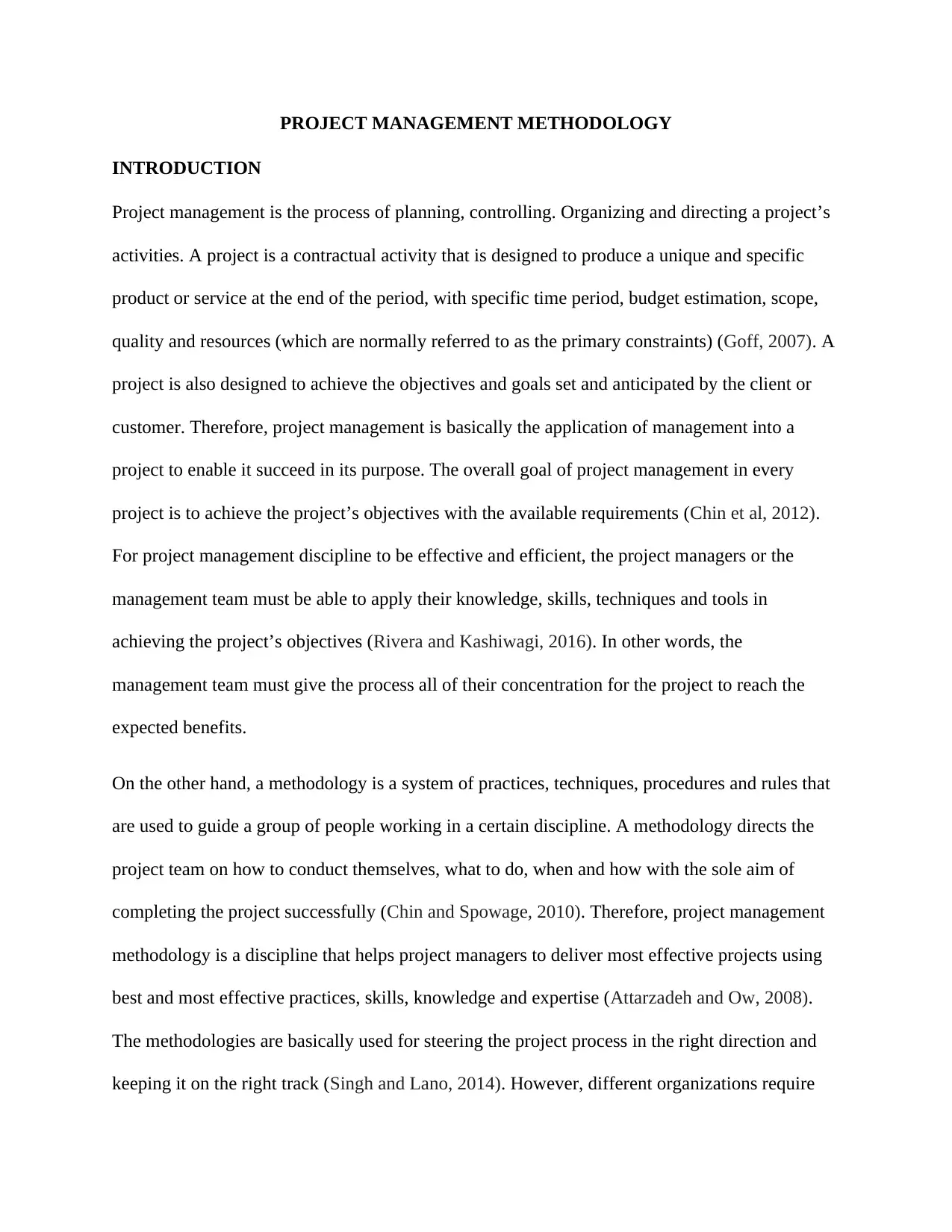
PROJECT MANAGEMENT METHODOLOGY
INTRODUCTION
Project management is the process of planning, controlling. Organizing and directing a project’s
activities. A project is a contractual activity that is designed to produce a unique and specific
product or service at the end of the period, with specific time period, budget estimation, scope,
quality and resources (which are normally referred to as the primary constraints) (Goff, 2007). A
project is also designed to achieve the objectives and goals set and anticipated by the client or
customer. Therefore, project management is basically the application of management into a
project to enable it succeed in its purpose. The overall goal of project management in every
project is to achieve the project’s objectives with the available requirements (Chin et al, 2012).
For project management discipline to be effective and efficient, the project managers or the
management team must be able to apply their knowledge, skills, techniques and tools in
achieving the project’s objectives (Rivera and Kashiwagi, 2016). In other words, the
management team must give the process all of their concentration for the project to reach the
expected benefits.
On the other hand, a methodology is a system of practices, techniques, procedures and rules that
are used to guide a group of people working in a certain discipline. A methodology directs the
project team on how to conduct themselves, what to do, when and how with the sole aim of
completing the project successfully (Chin and Spowage, 2010). Therefore, project management
methodology is a discipline that helps project managers to deliver most effective projects using
best and most effective practices, skills, knowledge and expertise (Attarzadeh and Ow, 2008).
The methodologies are basically used for steering the project process in the right direction and
keeping it on the right track (Singh and Lano, 2014). However, different organizations require
INTRODUCTION
Project management is the process of planning, controlling. Organizing and directing a project’s
activities. A project is a contractual activity that is designed to produce a unique and specific
product or service at the end of the period, with specific time period, budget estimation, scope,
quality and resources (which are normally referred to as the primary constraints) (Goff, 2007). A
project is also designed to achieve the objectives and goals set and anticipated by the client or
customer. Therefore, project management is basically the application of management into a
project to enable it succeed in its purpose. The overall goal of project management in every
project is to achieve the project’s objectives with the available requirements (Chin et al, 2012).
For project management discipline to be effective and efficient, the project managers or the
management team must be able to apply their knowledge, skills, techniques and tools in
achieving the project’s objectives (Rivera and Kashiwagi, 2016). In other words, the
management team must give the process all of their concentration for the project to reach the
expected benefits.
On the other hand, a methodology is a system of practices, techniques, procedures and rules that
are used to guide a group of people working in a certain discipline. A methodology directs the
project team on how to conduct themselves, what to do, when and how with the sole aim of
completing the project successfully (Chin and Spowage, 2010). Therefore, project management
methodology is a discipline that helps project managers to deliver most effective projects using
best and most effective practices, skills, knowledge and expertise (Attarzadeh and Ow, 2008).
The methodologies are basically used for steering the project process in the right direction and
keeping it on the right track (Singh and Lano, 2014). However, different organizations require
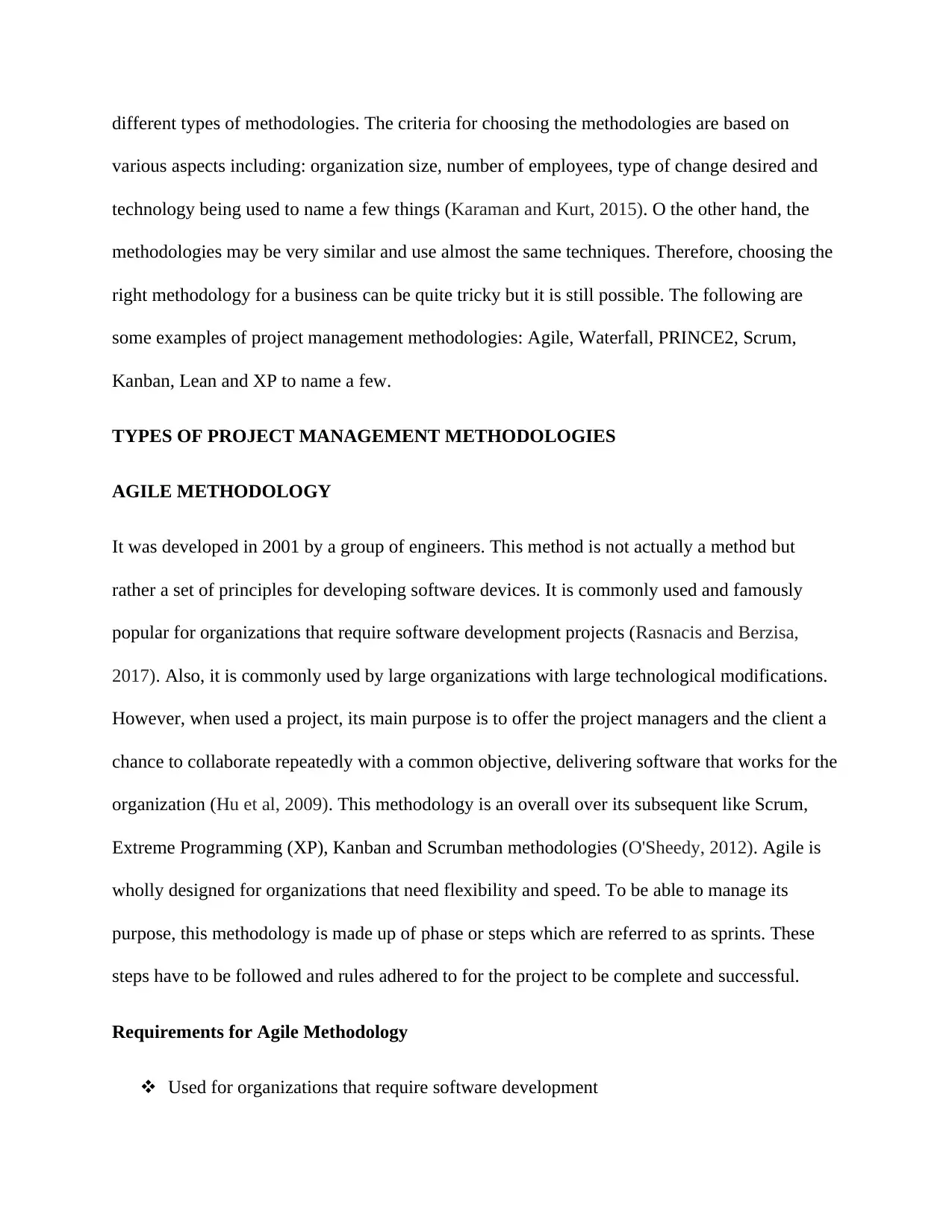
different types of methodologies. The criteria for choosing the methodologies are based on
various aspects including: organization size, number of employees, type of change desired and
technology being used to name a few things (Karaman and Kurt, 2015). O the other hand, the
methodologies may be very similar and use almost the same techniques. Therefore, choosing the
right methodology for a business can be quite tricky but it is still possible. The following are
some examples of project management methodologies: Agile, Waterfall, PRINCE2, Scrum,
Kanban, Lean and XP to name a few.
TYPES OF PROJECT MANAGEMENT METHODOLOGIES
AGILE METHODOLOGY
It was developed in 2001 by a group of engineers. This method is not actually a method but
rather a set of principles for developing software devices. It is commonly used and famously
popular for organizations that require software development projects (Rasnacis and Berzisa,
2017). Also, it is commonly used by large organizations with large technological modifications.
However, when used a project, its main purpose is to offer the project managers and the client a
chance to collaborate repeatedly with a common objective, delivering software that works for the
organization (Hu et al, 2009). This methodology is an overall over its subsequent like Scrum,
Extreme Programming (XP), Kanban and Scrumban methodologies (O'Sheedy, 2012). Agile is
wholly designed for organizations that need flexibility and speed. To be able to manage its
purpose, this methodology is made up of phase or steps which are referred to as sprints. These
steps have to be followed and rules adhered to for the project to be complete and successful.
Requirements for Agile Methodology
Used for organizations that require software development
various aspects including: organization size, number of employees, type of change desired and
technology being used to name a few things (Karaman and Kurt, 2015). O the other hand, the
methodologies may be very similar and use almost the same techniques. Therefore, choosing the
right methodology for a business can be quite tricky but it is still possible. The following are
some examples of project management methodologies: Agile, Waterfall, PRINCE2, Scrum,
Kanban, Lean and XP to name a few.
TYPES OF PROJECT MANAGEMENT METHODOLOGIES
AGILE METHODOLOGY
It was developed in 2001 by a group of engineers. This method is not actually a method but
rather a set of principles for developing software devices. It is commonly used and famously
popular for organizations that require software development projects (Rasnacis and Berzisa,
2017). Also, it is commonly used by large organizations with large technological modifications.
However, when used a project, its main purpose is to offer the project managers and the client a
chance to collaborate repeatedly with a common objective, delivering software that works for the
organization (Hu et al, 2009). This methodology is an overall over its subsequent like Scrum,
Extreme Programming (XP), Kanban and Scrumban methodologies (O'Sheedy, 2012). Agile is
wholly designed for organizations that need flexibility and speed. To be able to manage its
purpose, this methodology is made up of phase or steps which are referred to as sprints. These
steps have to be followed and rules adhered to for the project to be complete and successful.
Requirements for Agile Methodology
Used for organizations that require software development
⊘ This is a preview!⊘
Do you want full access?
Subscribe today to unlock all pages.

Trusted by 1+ million students worldwide

Used in large business organizations
Suitable for project requiring less control and monitoring
Used in projects that require frequent and effective communications between the client
and the project managers
Used in projects with flexible requirements and demands
Suitable Methodology for Organization C
The best project management methodology suitable for this organization is the Agile
methodology. This is simply because the organization is composed of most of the requirements
needed for Agile methodology. From the case study information, organization C has a very large
number of employees (1200) which technically makes it a large organization. Furthermore, the
organization has locations and customers all over the world which makes it an international
organization. In addition to that, it offers technological services which mean that its services are
related to software system development of any technological development or improvement
operations.
Organization C Characteristics
Is an international business organization
Deals with technological development and improvement services
Have a wide range of customers, i.e. large market share and segment
Has the largest number of employees
Agile Methodology Implementation Plan
Organization C should follow the following steps in order for it to implement this methodology
effectively (Stare, 2013):
Suitable for project requiring less control and monitoring
Used in projects that require frequent and effective communications between the client
and the project managers
Used in projects with flexible requirements and demands
Suitable Methodology for Organization C
The best project management methodology suitable for this organization is the Agile
methodology. This is simply because the organization is composed of most of the requirements
needed for Agile methodology. From the case study information, organization C has a very large
number of employees (1200) which technically makes it a large organization. Furthermore, the
organization has locations and customers all over the world which makes it an international
organization. In addition to that, it offers technological services which mean that its services are
related to software system development of any technological development or improvement
operations.
Organization C Characteristics
Is an international business organization
Deals with technological development and improvement services
Have a wide range of customers, i.e. large market share and segment
Has the largest number of employees
Agile Methodology Implementation Plan
Organization C should follow the following steps in order for it to implement this methodology
effectively (Stare, 2013):
Paraphrase This Document
Need a fresh take? Get an instant paraphrase of this document with our AI Paraphraser
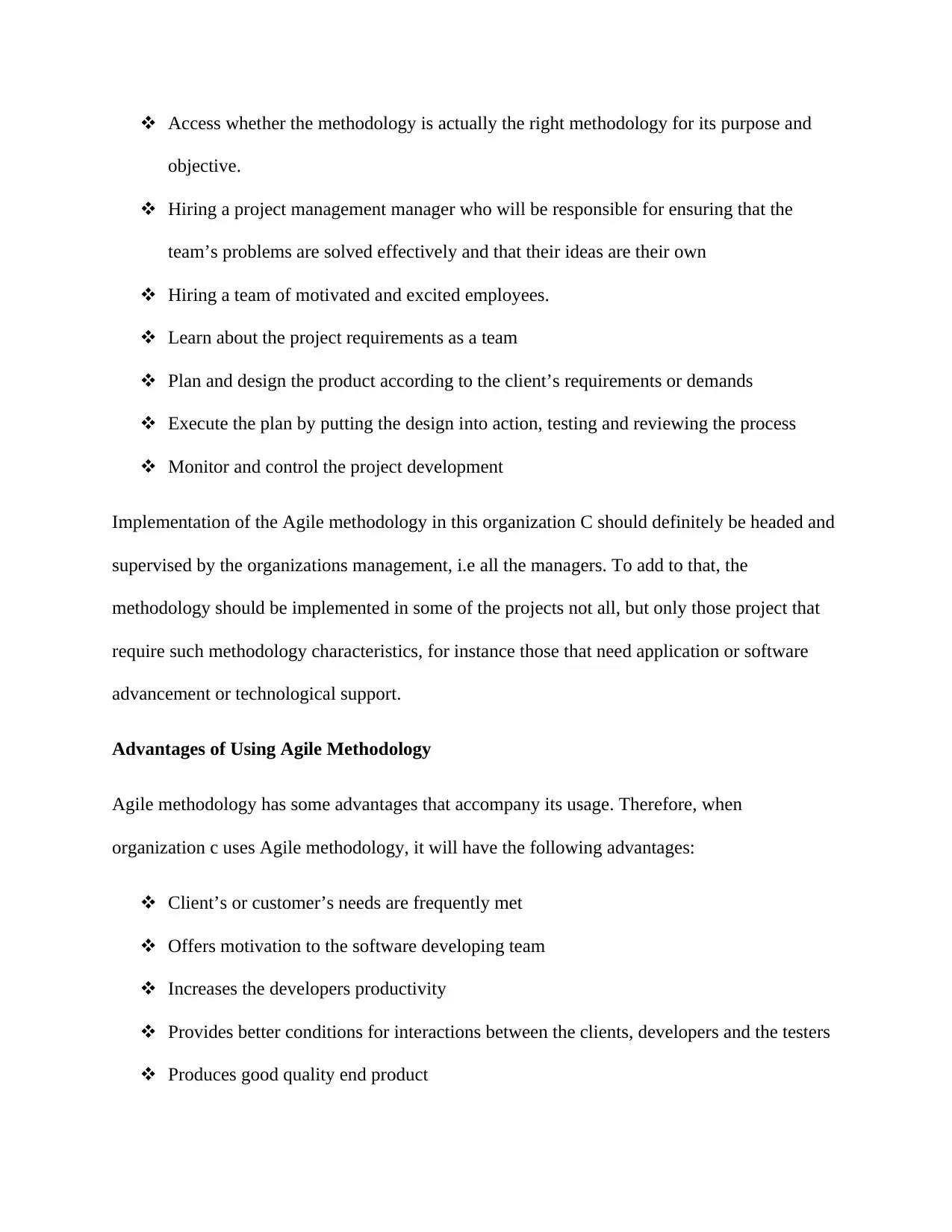
Access whether the methodology is actually the right methodology for its purpose and
objective.
Hiring a project management manager who will be responsible for ensuring that the
team’s problems are solved effectively and that their ideas are their own
Hiring a team of motivated and excited employees.
Learn about the project requirements as a team
Plan and design the product according to the client’s requirements or demands
Execute the plan by putting the design into action, testing and reviewing the process
Monitor and control the project development
Implementation of the Agile methodology in this organization C should definitely be headed and
supervised by the organizations management, i.e all the managers. To add to that, the
methodology should be implemented in some of the projects not all, but only those project that
require such methodology characteristics, for instance those that need application or software
advancement or technological support.
Advantages of Using Agile Methodology
Agile methodology has some advantages that accompany its usage. Therefore, when
organization c uses Agile methodology, it will have the following advantages:
Client’s or customer’s needs are frequently met
Offers motivation to the software developing team
Increases the developers productivity
Provides better conditions for interactions between the clients, developers and the testers
Produces good quality end product
objective.
Hiring a project management manager who will be responsible for ensuring that the
team’s problems are solved effectively and that their ideas are their own
Hiring a team of motivated and excited employees.
Learn about the project requirements as a team
Plan and design the product according to the client’s requirements or demands
Execute the plan by putting the design into action, testing and reviewing the process
Monitor and control the project development
Implementation of the Agile methodology in this organization C should definitely be headed and
supervised by the organizations management, i.e all the managers. To add to that, the
methodology should be implemented in some of the projects not all, but only those project that
require such methodology characteristics, for instance those that need application or software
advancement or technological support.
Advantages of Using Agile Methodology
Agile methodology has some advantages that accompany its usage. Therefore, when
organization c uses Agile methodology, it will have the following advantages:
Client’s or customer’s needs are frequently met
Offers motivation to the software developing team
Increases the developers productivity
Provides better conditions for interactions between the clients, developers and the testers
Produces good quality end product
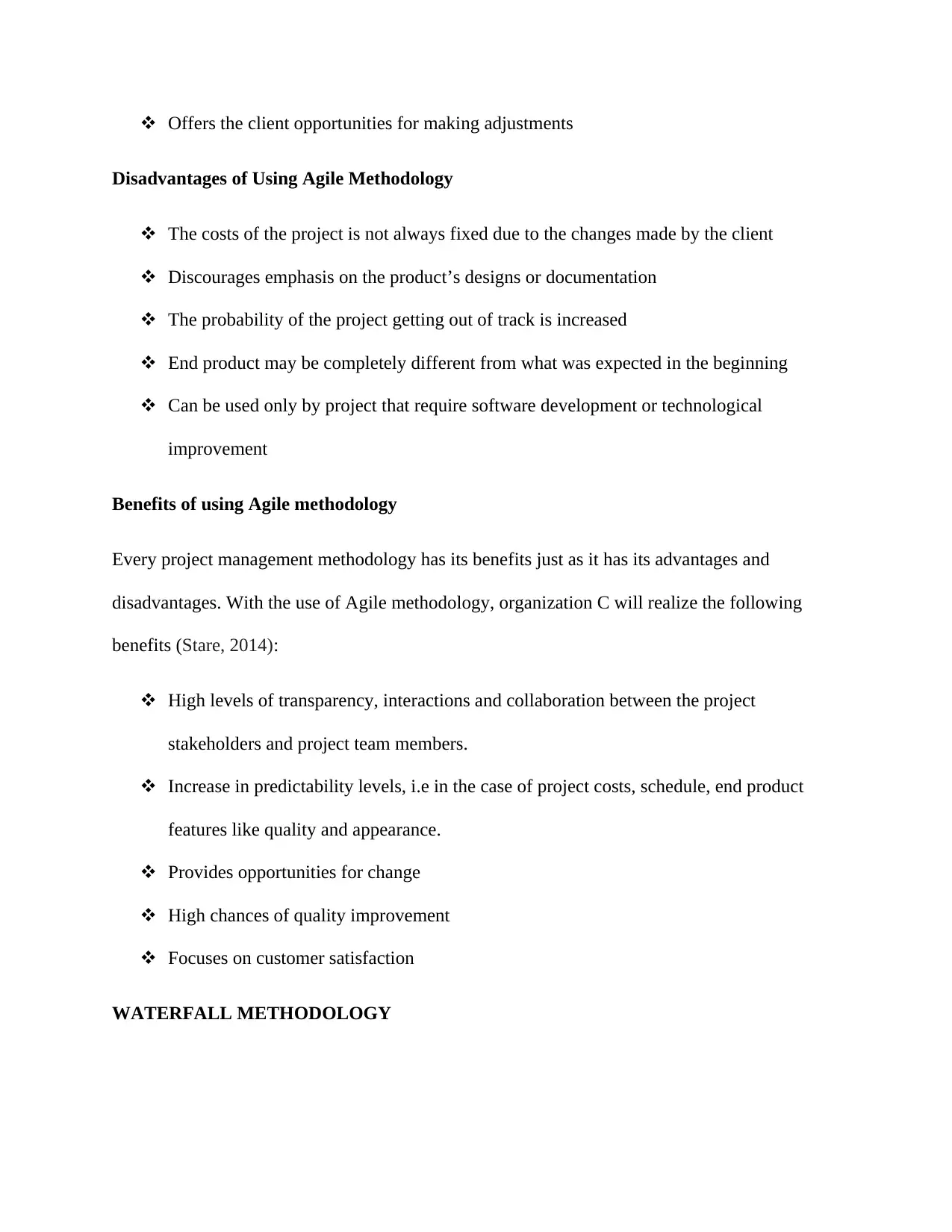
Offers the client opportunities for making adjustments
Disadvantages of Using Agile Methodology
The costs of the project is not always fixed due to the changes made by the client
Discourages emphasis on the product’s designs or documentation
The probability of the project getting out of track is increased
End product may be completely different from what was expected in the beginning
Can be used only by project that require software development or technological
improvement
Benefits of using Agile methodology
Every project management methodology has its benefits just as it has its advantages and
disadvantages. With the use of Agile methodology, organization C will realize the following
benefits (Stare, 2014):
High levels of transparency, interactions and collaboration between the project
stakeholders and project team members.
Increase in predictability levels, i.e in the case of project costs, schedule, end product
features like quality and appearance.
Provides opportunities for change
High chances of quality improvement
Focuses on customer satisfaction
WATERFALL METHODOLOGY
Disadvantages of Using Agile Methodology
The costs of the project is not always fixed due to the changes made by the client
Discourages emphasis on the product’s designs or documentation
The probability of the project getting out of track is increased
End product may be completely different from what was expected in the beginning
Can be used only by project that require software development or technological
improvement
Benefits of using Agile methodology
Every project management methodology has its benefits just as it has its advantages and
disadvantages. With the use of Agile methodology, organization C will realize the following
benefits (Stare, 2014):
High levels of transparency, interactions and collaboration between the project
stakeholders and project team members.
Increase in predictability levels, i.e in the case of project costs, schedule, end product
features like quality and appearance.
Provides opportunities for change
High chances of quality improvement
Focuses on customer satisfaction
WATERFALL METHODOLOGY
⊘ This is a preview!⊘
Do you want full access?
Subscribe today to unlock all pages.

Trusted by 1+ million students worldwide
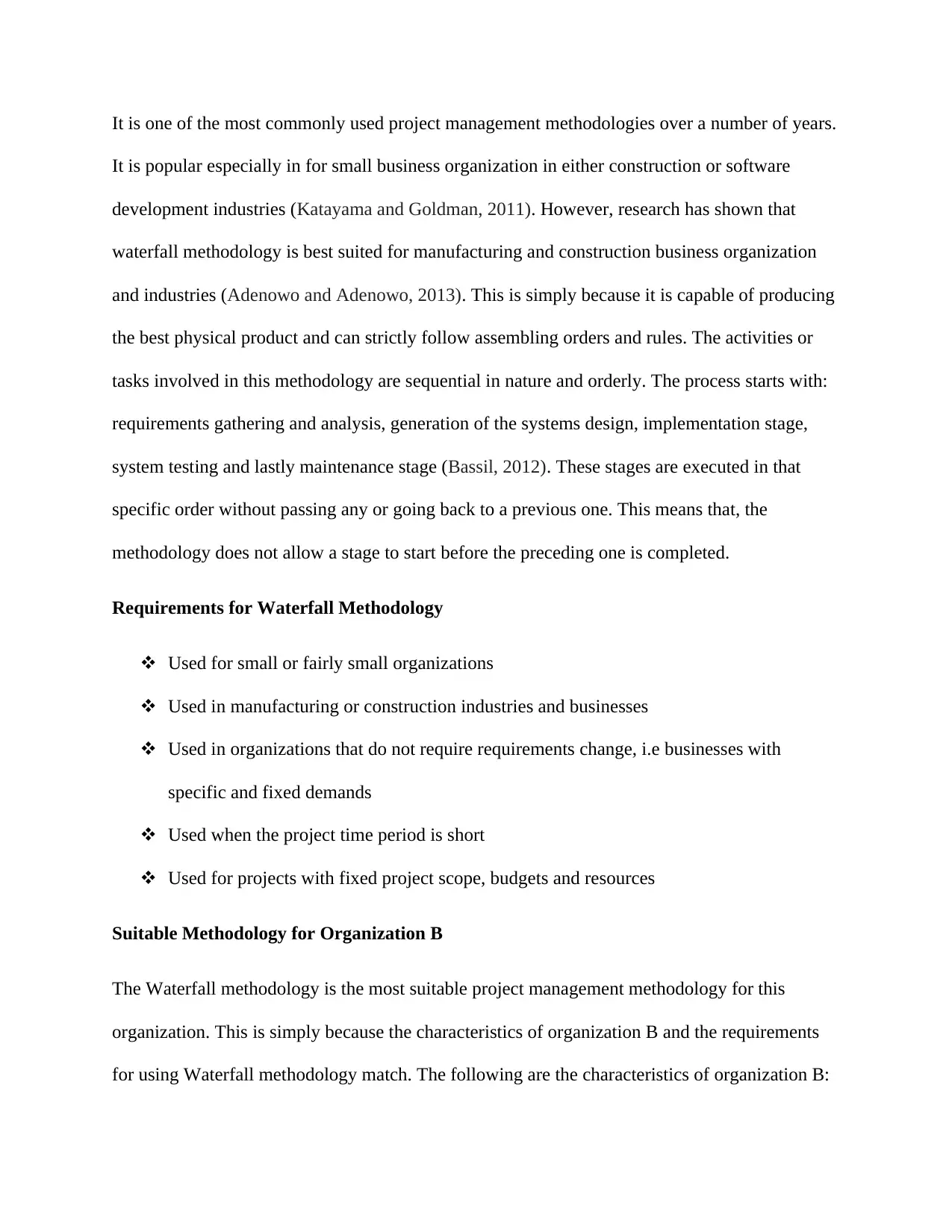
It is one of the most commonly used project management methodologies over a number of years.
It is popular especially in for small business organization in either construction or software
development industries (Katayama and Goldman, 2011). However, research has shown that
waterfall methodology is best suited for manufacturing and construction business organization
and industries (Adenowo and Adenowo, 2013). This is simply because it is capable of producing
the best physical product and can strictly follow assembling orders and rules. The activities or
tasks involved in this methodology are sequential in nature and orderly. The process starts with:
requirements gathering and analysis, generation of the systems design, implementation stage,
system testing and lastly maintenance stage (Bassil, 2012). These stages are executed in that
specific order without passing any or going back to a previous one. This means that, the
methodology does not allow a stage to start before the preceding one is completed.
Requirements for Waterfall Methodology
Used for small or fairly small organizations
Used in manufacturing or construction industries and businesses
Used in organizations that do not require requirements change, i.e businesses with
specific and fixed demands
Used when the project time period is short
Used for projects with fixed project scope, budgets and resources
Suitable Methodology for Organization B
The Waterfall methodology is the most suitable project management methodology for this
organization. This is simply because the characteristics of organization B and the requirements
for using Waterfall methodology match. The following are the characteristics of organization B:
It is popular especially in for small business organization in either construction or software
development industries (Katayama and Goldman, 2011). However, research has shown that
waterfall methodology is best suited for manufacturing and construction business organization
and industries (Adenowo and Adenowo, 2013). This is simply because it is capable of producing
the best physical product and can strictly follow assembling orders and rules. The activities or
tasks involved in this methodology are sequential in nature and orderly. The process starts with:
requirements gathering and analysis, generation of the systems design, implementation stage,
system testing and lastly maintenance stage (Bassil, 2012). These stages are executed in that
specific order without passing any or going back to a previous one. This means that, the
methodology does not allow a stage to start before the preceding one is completed.
Requirements for Waterfall Methodology
Used for small or fairly small organizations
Used in manufacturing or construction industries and businesses
Used in organizations that do not require requirements change, i.e businesses with
specific and fixed demands
Used when the project time period is short
Used for projects with fixed project scope, budgets and resources
Suitable Methodology for Organization B
The Waterfall methodology is the most suitable project management methodology for this
organization. This is simply because the characteristics of organization B and the requirements
for using Waterfall methodology match. The following are the characteristics of organization B:
Paraphrase This Document
Need a fresh take? Get an instant paraphrase of this document with our AI Paraphraser
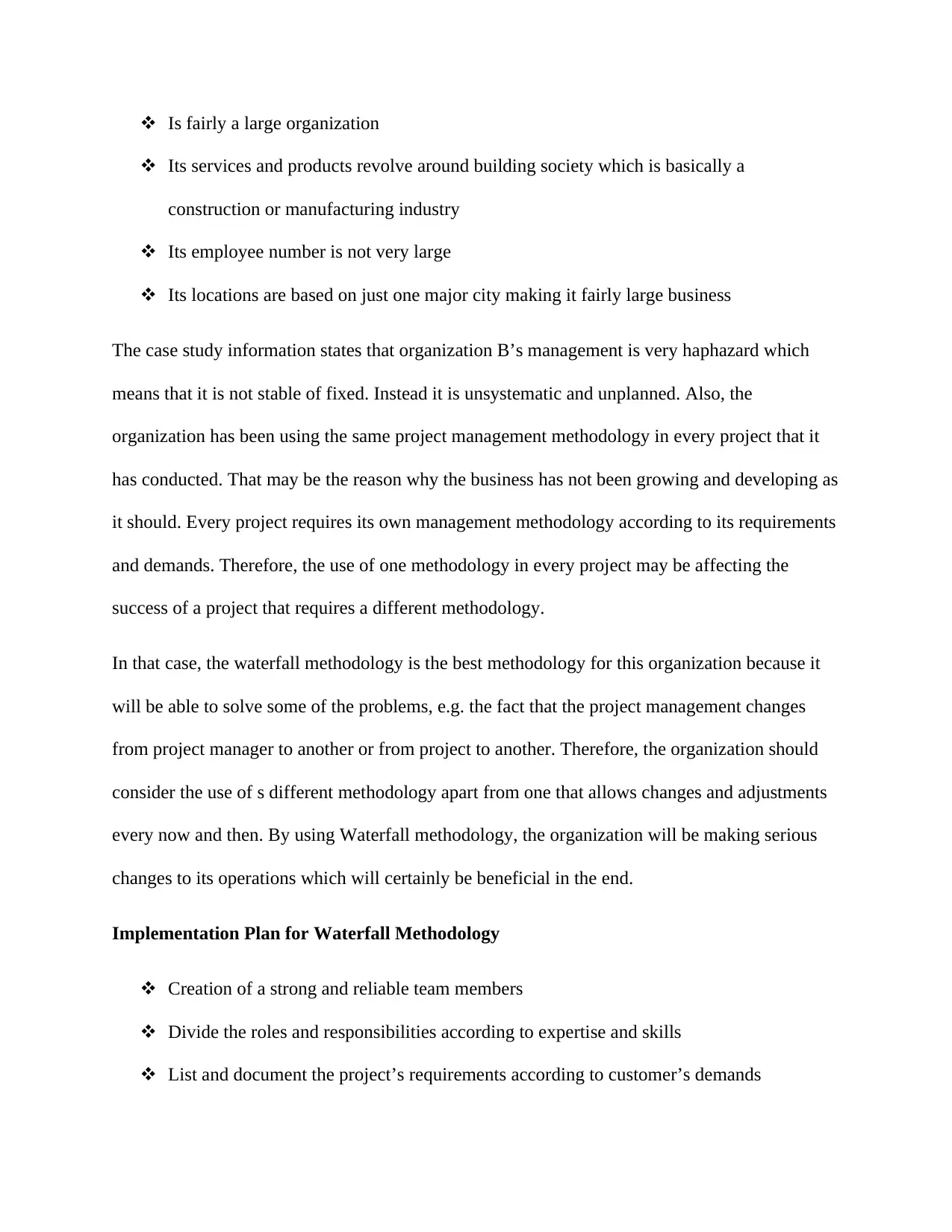
Is fairly a large organization
Its services and products revolve around building society which is basically a
construction or manufacturing industry
Its employee number is not very large
Its locations are based on just one major city making it fairly large business
The case study information states that organization B’s management is very haphazard which
means that it is not stable of fixed. Instead it is unsystematic and unplanned. Also, the
organization has been using the same project management methodology in every project that it
has conducted. That may be the reason why the business has not been growing and developing as
it should. Every project requires its own management methodology according to its requirements
and demands. Therefore, the use of one methodology in every project may be affecting the
success of a project that requires a different methodology.
In that case, the waterfall methodology is the best methodology for this organization because it
will be able to solve some of the problems, e.g. the fact that the project management changes
from project manager to another or from project to another. Therefore, the organization should
consider the use of s different methodology apart from one that allows changes and adjustments
every now and then. By using Waterfall methodology, the organization will be making serious
changes to its operations which will certainly be beneficial in the end.
Implementation Plan for Waterfall Methodology
Creation of a strong and reliable team members
Divide the roles and responsibilities according to expertise and skills
List and document the project’s requirements according to customer’s demands
Its services and products revolve around building society which is basically a
construction or manufacturing industry
Its employee number is not very large
Its locations are based on just one major city making it fairly large business
The case study information states that organization B’s management is very haphazard which
means that it is not stable of fixed. Instead it is unsystematic and unplanned. Also, the
organization has been using the same project management methodology in every project that it
has conducted. That may be the reason why the business has not been growing and developing as
it should. Every project requires its own management methodology according to its requirements
and demands. Therefore, the use of one methodology in every project may be affecting the
success of a project that requires a different methodology.
In that case, the waterfall methodology is the best methodology for this organization because it
will be able to solve some of the problems, e.g. the fact that the project management changes
from project manager to another or from project to another. Therefore, the organization should
consider the use of s different methodology apart from one that allows changes and adjustments
every now and then. By using Waterfall methodology, the organization will be making serious
changes to its operations which will certainly be beneficial in the end.
Implementation Plan for Waterfall Methodology
Creation of a strong and reliable team members
Divide the roles and responsibilities according to expertise and skills
List and document the project’s requirements according to customer’s demands
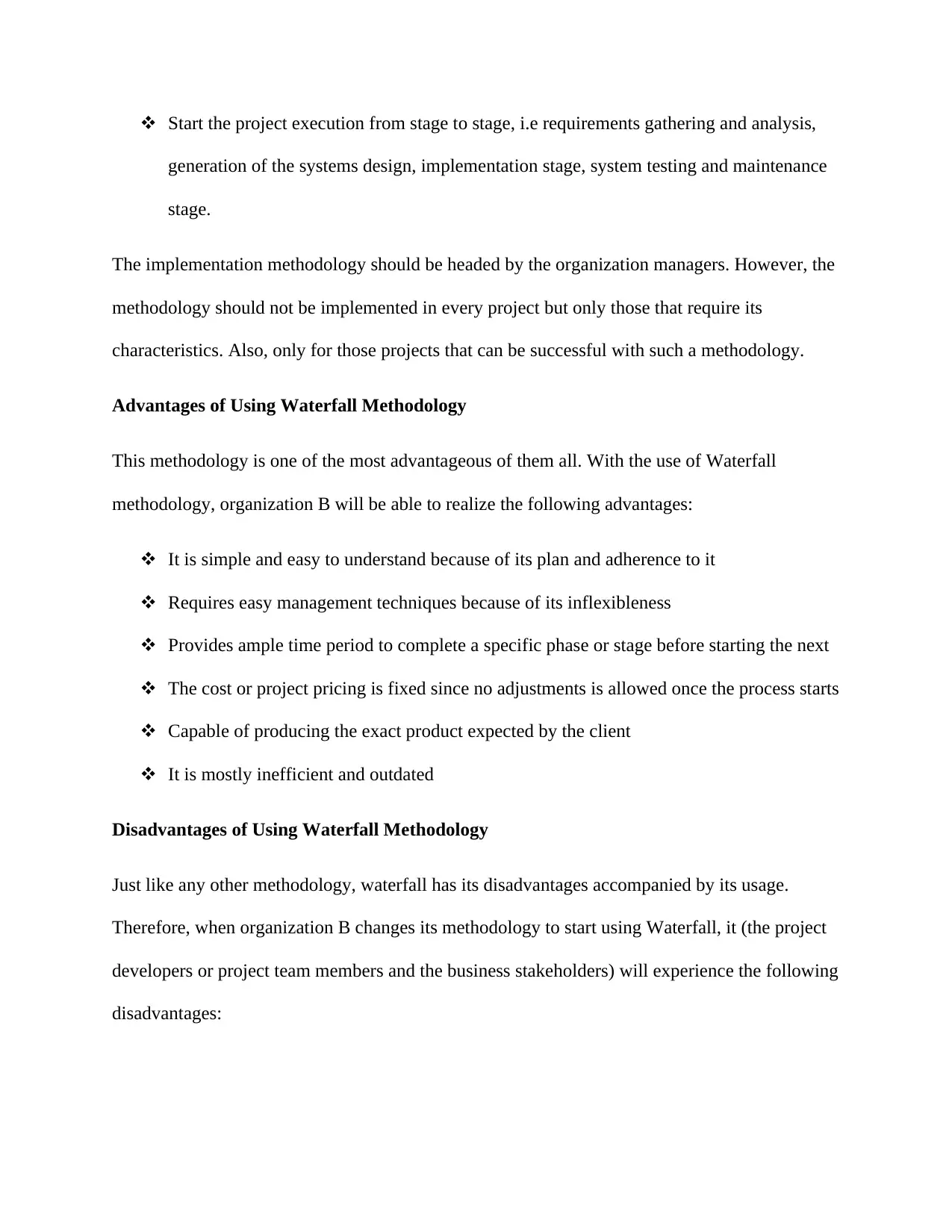
Start the project execution from stage to stage, i.e requirements gathering and analysis,
generation of the systems design, implementation stage, system testing and maintenance
stage.
The implementation methodology should be headed by the organization managers. However, the
methodology should not be implemented in every project but only those that require its
characteristics. Also, only for those projects that can be successful with such a methodology.
Advantages of Using Waterfall Methodology
This methodology is one of the most advantageous of them all. With the use of Waterfall
methodology, organization B will be able to realize the following advantages:
It is simple and easy to understand because of its plan and adherence to it
Requires easy management techniques because of its inflexibleness
Provides ample time period to complete a specific phase or stage before starting the next
The cost or project pricing is fixed since no adjustments is allowed once the process starts
Capable of producing the exact product expected by the client
It is mostly inefficient and outdated
Disadvantages of Using Waterfall Methodology
Just like any other methodology, waterfall has its disadvantages accompanied by its usage.
Therefore, when organization B changes its methodology to start using Waterfall, it (the project
developers or project team members and the business stakeholders) will experience the following
disadvantages:
generation of the systems design, implementation stage, system testing and maintenance
stage.
The implementation methodology should be headed by the organization managers. However, the
methodology should not be implemented in every project but only those that require its
characteristics. Also, only for those projects that can be successful with such a methodology.
Advantages of Using Waterfall Methodology
This methodology is one of the most advantageous of them all. With the use of Waterfall
methodology, organization B will be able to realize the following advantages:
It is simple and easy to understand because of its plan and adherence to it
Requires easy management techniques because of its inflexibleness
Provides ample time period to complete a specific phase or stage before starting the next
The cost or project pricing is fixed since no adjustments is allowed once the process starts
Capable of producing the exact product expected by the client
It is mostly inefficient and outdated
Disadvantages of Using Waterfall Methodology
Just like any other methodology, waterfall has its disadvantages accompanied by its usage.
Therefore, when organization B changes its methodology to start using Waterfall, it (the project
developers or project team members and the business stakeholders) will experience the following
disadvantages:
⊘ This is a preview!⊘
Do you want full access?
Subscribe today to unlock all pages.

Trusted by 1+ million students worldwide
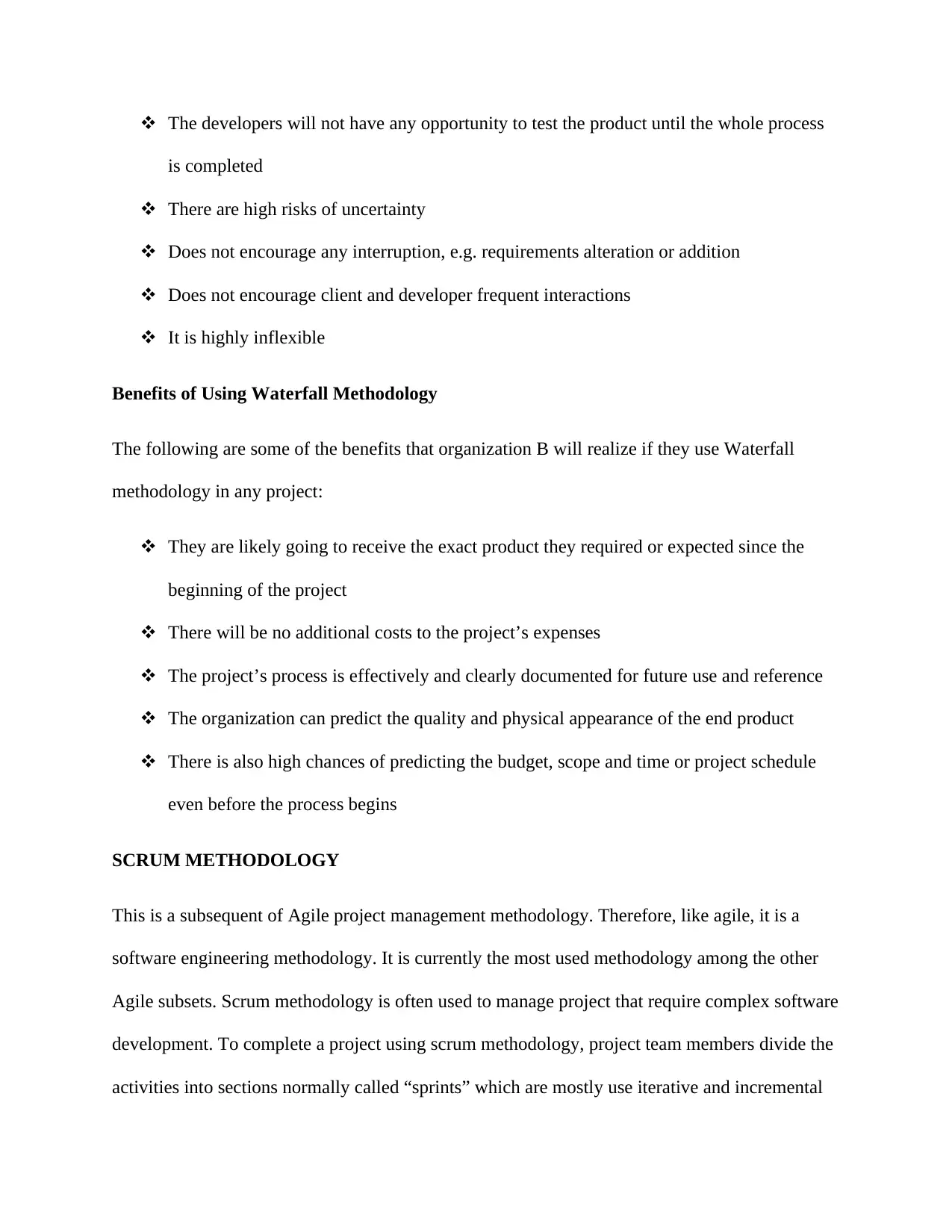
The developers will not have any opportunity to test the product until the whole process
is completed
There are high risks of uncertainty
Does not encourage any interruption, e.g. requirements alteration or addition
Does not encourage client and developer frequent interactions
It is highly inflexible
Benefits of Using Waterfall Methodology
The following are some of the benefits that organization B will realize if they use Waterfall
methodology in any project:
They are likely going to receive the exact product they required or expected since the
beginning of the project
There will be no additional costs to the project’s expenses
The project’s process is effectively and clearly documented for future use and reference
The organization can predict the quality and physical appearance of the end product
There is also high chances of predicting the budget, scope and time or project schedule
even before the process begins
SCRUM METHODOLOGY
This is a subsequent of Agile project management methodology. Therefore, like agile, it is a
software engineering methodology. It is currently the most used methodology among the other
Agile subsets. Scrum methodology is often used to manage project that require complex software
development. To complete a project using scrum methodology, project team members divide the
activities into sections normally called “sprints” which are mostly use iterative and incremental
is completed
There are high risks of uncertainty
Does not encourage any interruption, e.g. requirements alteration or addition
Does not encourage client and developer frequent interactions
It is highly inflexible
Benefits of Using Waterfall Methodology
The following are some of the benefits that organization B will realize if they use Waterfall
methodology in any project:
They are likely going to receive the exact product they required or expected since the
beginning of the project
There will be no additional costs to the project’s expenses
The project’s process is effectively and clearly documented for future use and reference
The organization can predict the quality and physical appearance of the end product
There is also high chances of predicting the budget, scope and time or project schedule
even before the process begins
SCRUM METHODOLOGY
This is a subsequent of Agile project management methodology. Therefore, like agile, it is a
software engineering methodology. It is currently the most used methodology among the other
Agile subsets. Scrum methodology is often used to manage project that require complex software
development. To complete a project using scrum methodology, project team members divide the
activities into sections normally called “sprints” which are mostly use iterative and incremental
Paraphrase This Document
Need a fresh take? Get an instant paraphrase of this document with our AI Paraphraser
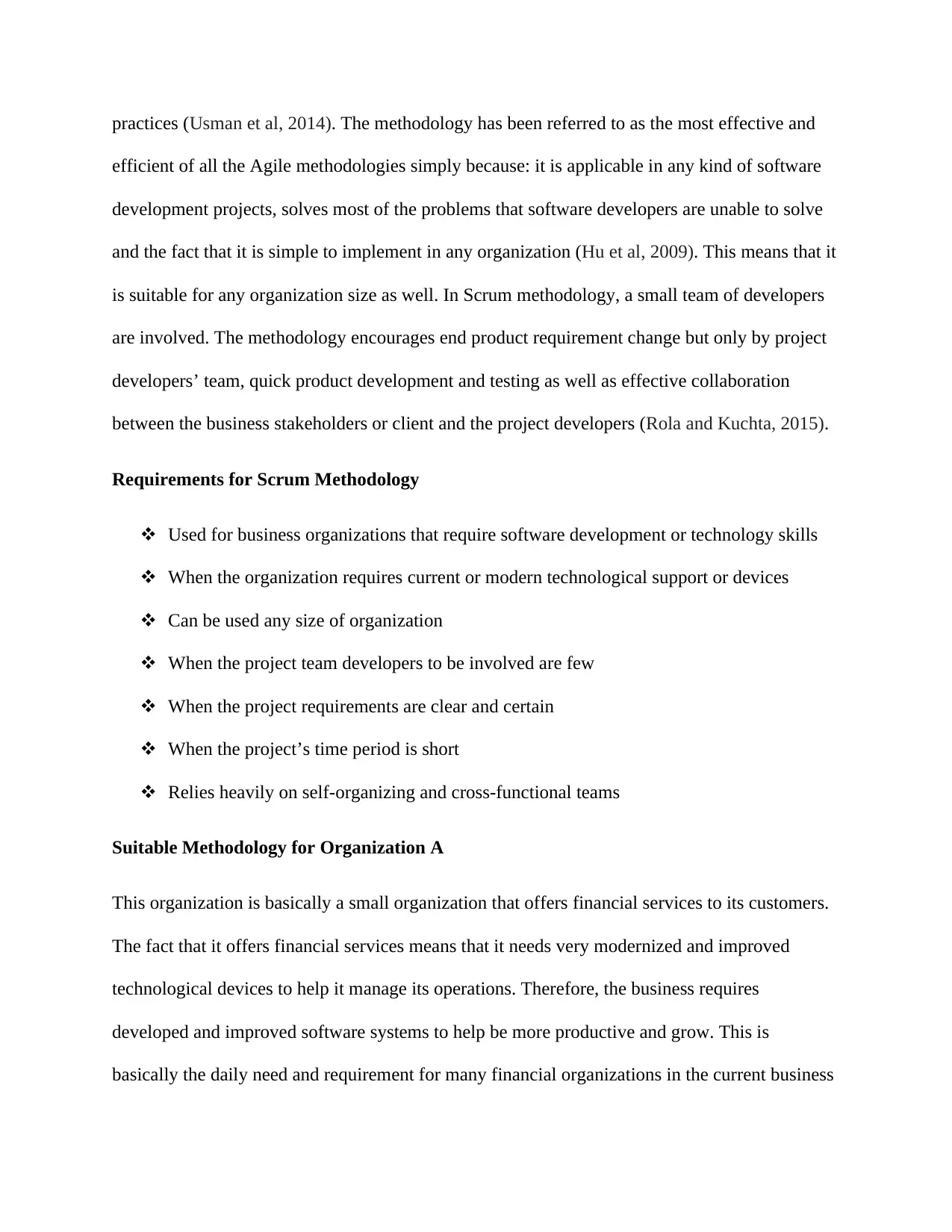
practices (Usman et al, 2014). The methodology has been referred to as the most effective and
efficient of all the Agile methodologies simply because: it is applicable in any kind of software
development projects, solves most of the problems that software developers are unable to solve
and the fact that it is simple to implement in any organization (Hu et al, 2009). This means that it
is suitable for any organization size as well. In Scrum methodology, a small team of developers
are involved. The methodology encourages end product requirement change but only by project
developers’ team, quick product development and testing as well as effective collaboration
between the business stakeholders or client and the project developers (Rola and Kuchta, 2015).
Requirements for Scrum Methodology
Used for business organizations that require software development or technology skills
When the organization requires current or modern technological support or devices
Can be used any size of organization
When the project team developers to be involved are few
When the project requirements are clear and certain
When the project’s time period is short
Relies heavily on self-organizing and cross-functional teams
Suitable Methodology for Organization A
This organization is basically a small organization that offers financial services to its customers.
The fact that it offers financial services means that it needs very modernized and improved
technological devices to help it manage its operations. Therefore, the business requires
developed and improved software systems to help be more productive and grow. This is
basically the daily need and requirement for many financial organizations in the current business
efficient of all the Agile methodologies simply because: it is applicable in any kind of software
development projects, solves most of the problems that software developers are unable to solve
and the fact that it is simple to implement in any organization (Hu et al, 2009). This means that it
is suitable for any organization size as well. In Scrum methodology, a small team of developers
are involved. The methodology encourages end product requirement change but only by project
developers’ team, quick product development and testing as well as effective collaboration
between the business stakeholders or client and the project developers (Rola and Kuchta, 2015).
Requirements for Scrum Methodology
Used for business organizations that require software development or technology skills
When the organization requires current or modern technological support or devices
Can be used any size of organization
When the project team developers to be involved are few
When the project requirements are clear and certain
When the project’s time period is short
Relies heavily on self-organizing and cross-functional teams
Suitable Methodology for Organization A
This organization is basically a small organization that offers financial services to its customers.
The fact that it offers financial services means that it needs very modernized and improved
technological devices to help it manage its operations. Therefore, the business requires
developed and improved software systems to help be more productive and grow. This is
basically the daily need and requirement for many financial organizations in the current business
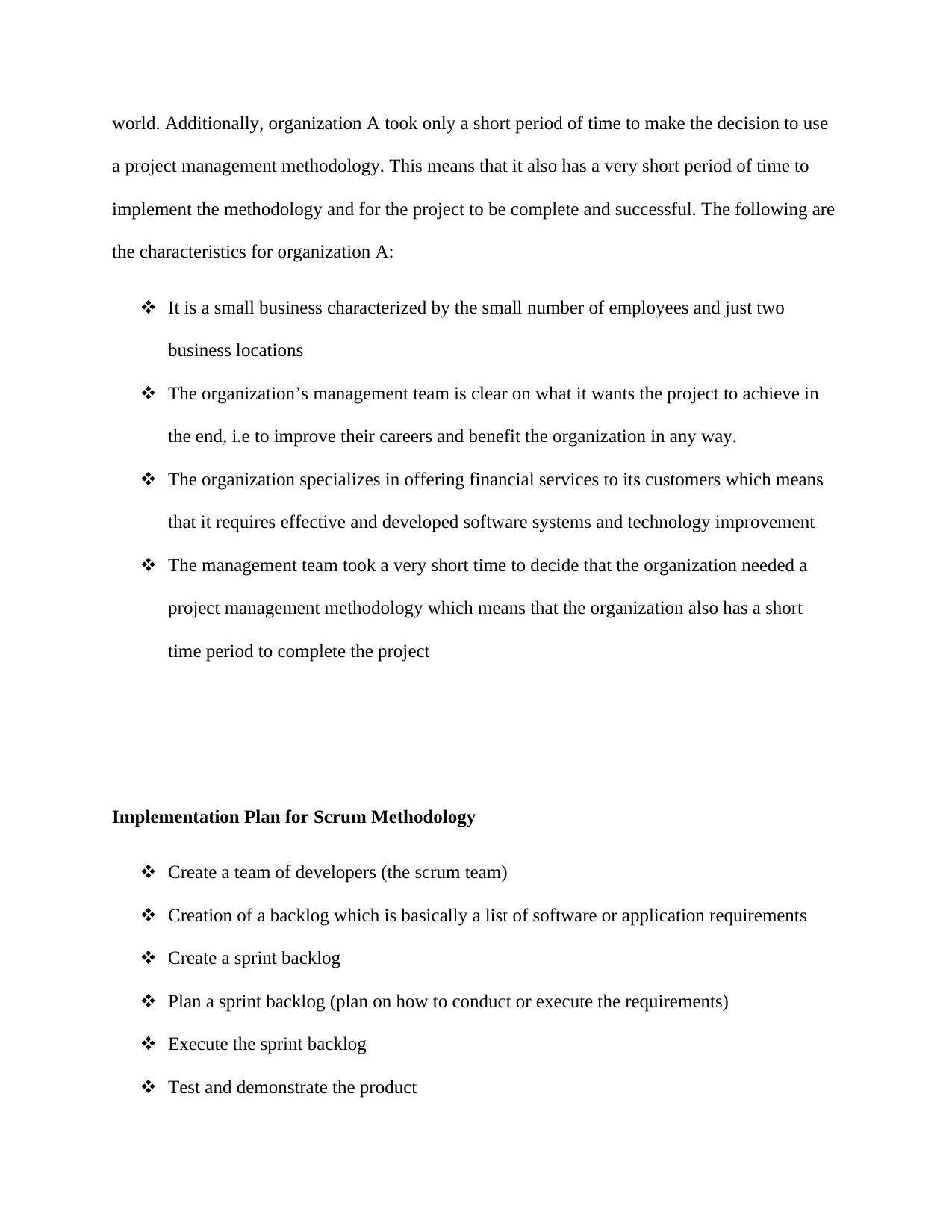
world. Additionally, organization A took only a short period of time to make the decision to use
a project management methodology. This means that it also has a very short period of time to
implement the methodology and for the project to be complete and successful. The following are
the characteristics for organization A:
It is a small business characterized by the small number of employees and just two
business locations
The organization’s management team is clear on what it wants the project to achieve in
the end, i.e to improve their careers and benefit the organization in any way.
The organization specializes in offering financial services to its customers which means
that it requires effective and developed software systems and technology improvement
The management team took a very short time to decide that the organization needed a
project management methodology which means that the organization also has a short
time period to complete the project
Implementation Plan for Scrum Methodology
Create a team of developers (the scrum team)
Creation of a backlog which is basically a list of software or application requirements
Create a sprint backlog
Plan a sprint backlog (plan on how to conduct or execute the requirements)
Execute the sprint backlog
Test and demonstrate the product
a project management methodology. This means that it also has a very short period of time to
implement the methodology and for the project to be complete and successful. The following are
the characteristics for organization A:
It is a small business characterized by the small number of employees and just two
business locations
The organization’s management team is clear on what it wants the project to achieve in
the end, i.e to improve their careers and benefit the organization in any way.
The organization specializes in offering financial services to its customers which means
that it requires effective and developed software systems and technology improvement
The management team took a very short time to decide that the organization needed a
project management methodology which means that the organization also has a short
time period to complete the project
Implementation Plan for Scrum Methodology
Create a team of developers (the scrum team)
Creation of a backlog which is basically a list of software or application requirements
Create a sprint backlog
Plan a sprint backlog (plan on how to conduct or execute the requirements)
Execute the sprint backlog
Test and demonstrate the product
⊘ This is a preview!⊘
Do you want full access?
Subscribe today to unlock all pages.

Trusted by 1+ million students worldwide
1 out of 16
Related Documents
Your All-in-One AI-Powered Toolkit for Academic Success.
+13062052269
info@desklib.com
Available 24*7 on WhatsApp / Email
![[object Object]](/_next/static/media/star-bottom.7253800d.svg)
Unlock your academic potential
Copyright © 2020–2025 A2Z Services. All Rights Reserved. Developed and managed by ZUCOL.




